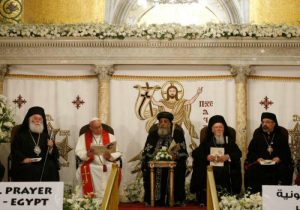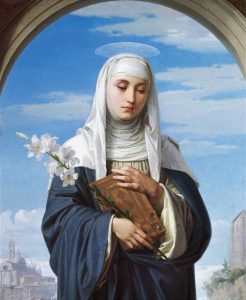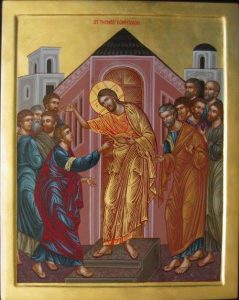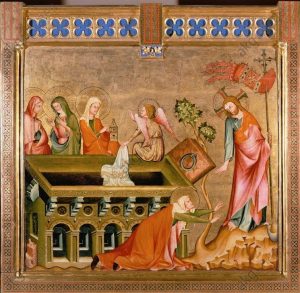 Today, the first time in history that the Patriarchs of Rome, Constantinople, & Alexandria (Greek & Coptic) have been in the same place, same time.
Today, the first time in history that the Patriarchs of Rome, Constantinople, & Alexandria (Greek & Coptic) have been in the same place, same time.
St Peter, St Mark and St Paul, pray for us.
May the Theotokos guide us to her Son.
 “The soul, who is lifted by a very great and yearning desire for the honor of God and the salvation of souls, begins by exercising herself, for a certain space of time, in the ordinary virtues, remaining in the cell of self-knowledge, in order to know better the goodness of God towards her. This she does because knowledge must precede love, and only when she has attained love, can she strive to follow and to clothe herself with the truth. But, in no way, does the creature receive such a taste of the truth, or so brilliant a light therefrom, as by means of humble and continuous prayer, founded on knowledge of herself and of God; because prayer, exercising her in the above way, unites with God the soul that follows the footprints of Christ Crucified, and thus, by desire and affection, and union of love, makes her another Himself.”
“The soul, who is lifted by a very great and yearning desire for the honor of God and the salvation of souls, begins by exercising herself, for a certain space of time, in the ordinary virtues, remaining in the cell of self-knowledge, in order to know better the goodness of God towards her. This she does because knowledge must precede love, and only when she has attained love, can she strive to follow and to clothe herself with the truth. But, in no way, does the creature receive such a taste of the truth, or so brilliant a light therefrom, as by means of humble and continuous prayer, founded on knowledge of herself and of God; because prayer, exercising her in the above way, unites with God the soul that follows the footprints of Christ Crucified, and thus, by desire and affection, and union of love, makes her another Himself.”
— St. Catherine of Siena, The Dialogue of St. Catherine of Siena, p.1
Indeed, mercy is the central nucleus of the Gospel message; it is the very name of God, the Face with which he revealed himself in the Old Covenant and fully in Jesus Christ, the incarnation of creative and redemptive Love. May this merciful love also shine on the face of the Church and show itself through the sacraments, in particular that of Reconciliation, and in works of charity, both communitarian and individual. May all that the Church says and does manifest the mercy God feels for man, and therefore for us. When the Church has to recall an unrecognized truth or a betrayed good, she always does so impelled by merciful love, so that men and women may have life and have it abundantly (cf. Jn 10:10). From Divine Mercy, which brings peace to hearts, genuine peace flows into the world, peace between different peoples, cultures and religions.
Pope Benedict XVI
Regina Caeli message,
Divine Mercy Sunday, March 30, 2008
 Today is Thomas Sunday. Also known by other names, Low Sunday and now Divine Mercy Sunday. The Church asks to make connections between what we commemorate in the Incarnation and the Resurrection. Today is a fitting day to account for our faith in what the Lord said and did was true.
Today is Thomas Sunday. Also known by other names, Low Sunday and now Divine Mercy Sunday. The Church asks to make connections between what we commemorate in the Incarnation and the Resurrection. Today is a fitting day to account for our faith in what the Lord said and did was true.
St. Thomas gives witness: what do we believe and what do we do? St. Thomas also opens for us the new mission given my the Lord Himself began when the Father missioned Him. Consider a few things taught in the Catechism we read:
“Jesus is often addressed as “Lord” in the gospels as a sign of respect and trust. In the encounter with the risen Jesus, this title becomes adoration: “My Lord and my God!” (Jn 20.28) and “It is the Lord!” (Jn 21.7). (CCC 448)
“When his visible presence was taken from them, Christ did not leave his disciples orphans but remained with them to the end of time by the outpouring of the Holy Spirit. As a result, our communion with Jesus has become in a way more intense.” (CCC 788).
AND
“Jesus is the Father’s Emissary, the one the Father has sent. Jesus, in turn, chooses and sends out the Twelve to preach in his name (Mk 3.13-14). These are his emissaries (Greek apostoloi), in whom Christ continues his own mission: “As the Father has sent me, even so I send you” (Jn 20.21) and “He who receives you receives me” (Mt 1.40; Lk 10.16). (CCC 858).
The full appreciation of the Paschal Mystery maintains a connection with the Feast of the Nativity. Archbishop DiNoia recently preached the following:
The Resurrection of Christ is in a real sense the fulfillment of the Annunciation when Mary’s fiat opened the way to our redemption, and her own. The body of our risen Lord—the same body he offered in sacrifice on the cross—was the body he received from Mary in the womb. What is more, Easter has made her what we hope to be as well. “Welcoming the risen Jesus, Mary is … a sign and anticipation of humanity which hopes to achieve its fulfilment through the resurrection of the dead” (Pope St. John Paul II, General Audience, 21 May 1997). Our Lady is the first one to share in the resurrection of her Son, the first fruits, as it were, of Easter: assumed into heaven and now reigning as Queen of Heaven, she anticipates the resurrection of our bodies and the life of bliss to come. How easy it is to imagine with Sedulius that she who was “the way by which he once came to us, might also signal his return.”
At Easter, we call on Mary to rejoice—Regina coeli, laetare—thus “prolonging in time the ‘rejoice’ that the Angel addressed to her at the Annunciation” (Pope St. John Paul II, General Audience, 21 May 1997). While the (probably Franciscan) author of this wonderful antiphon is unknown, there is a beautiful legend that Pope St. Gregory the Great—as he followed barefoot in procession with St. Luke’s icon of Mary—heard angels singing the first lines, and added what would become the antiphon’s concluding line: “Ora pro nobis Deum, Alleluia.”
Archbishop J. Augustine DiNoia, O.P.
April 16, 2017
DHS
Islam is a real big topic these days on all fronts: theology, politics, social, economic. One might add a question of reasonableness of the communication of and with the Divine Being through the Prophet. Christians will call Islam an form for Christian heresy. Whatever the case may be there is a worldwide crisis of identity and truth. Egyptian Copts just faced an attack that killed 50 people and terrorized many others. This is on top of prior attacks of terror by the Islamists.
A recent interview, in advance of Pope Francis’ visit to Egypt, was published by the National Catholic Register. Jesuit Father Samir Khalil Samir’s interview commands our attention. Father Samir is an expert. He is Egyptian and professor of Islamic studies at the Pontifical Oriental Institute in Rome.
 Dear friends in Christ: today, right now, we realize that our lives are filled with Divine meaning. Our personal stories are a part of a much bigger narrative. Your life, my life — our lives are all a part of the story of the family of God and the history of salvation. Jesus Christ is the point of unity and completeness in God.
Dear friends in Christ: today, right now, we realize that our lives are filled with Divine meaning. Our personal stories are a part of a much bigger narrative. Your life, my life — our lives are all a part of the story of the family of God and the history of salvation. Jesus Christ is the point of unity and completeness in God.
In the First Ode of the Canon of Pascha, we read (sing):
It is the day of Resurrection! O people, let us be enlightened by it.
The Passover is the Lord’s Passover,
snce Chrits our God has brought us from death to life,
and from earth to heaven,
Therefore we sing the hymn of victory!
CHRIST IS RISEN FRM THE DEAD!
Let us cleanse our sense that we may see the risen Christ,
in the glory of the Resurrection and clearly hear Him greetinbg us:
Rejoice! as we sing the hymn of victory!
CHRIST IS RISEN FROM THE DEAD!
Let the heaves properly rejoice and let the earth be glad;
and let the whole visible and invisble world celebrate,
for Christ, our everlastng joy, is rosen!
CHRIST IS RISEN FROM THE DEAD!
It is the day of Resurrection! O people, let us be enlightened by it.
The Passover is the Lord’s Passover,
snce Chrits our God has brought us from death to life,
and from earth to heaven,
Therefore we sing the hymn of victory!
Happy Easter!
“Do not lament me, O Mother, seeing me in the tomb, the Son conceived in the womb without seed, for I shall arise and be glorified with eternal glory as God. I shall exalt all who magnify thee in faith and in love.”
~Ode IX, Holy Saturday Matins/Paschal Nocturns
(Icon of the Mater Dolorosa by the hand of Cheryl Pituch, Robert, LA)
“What is it to believe?” asked the Welsh poet, Waldo Williams. He answers, “Giving solace / Until deliverance arrives.”
Today, Good Friday, we come to a deeper aware that “This is the Lord; we have waited for him; let us be glad and rejoice in his salvation.”
By your passion and cross we are, indeed, brought to communion.